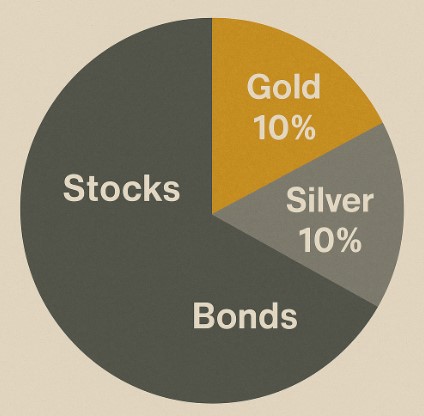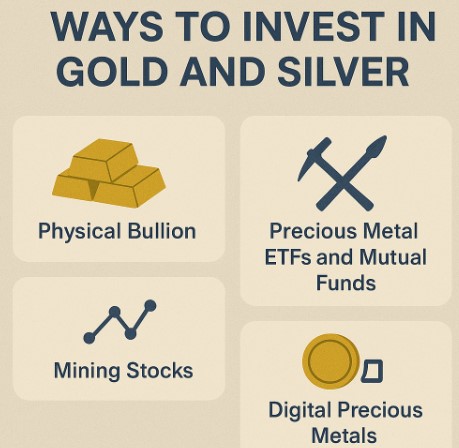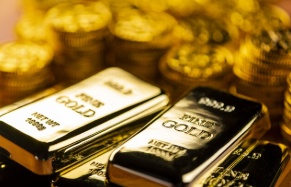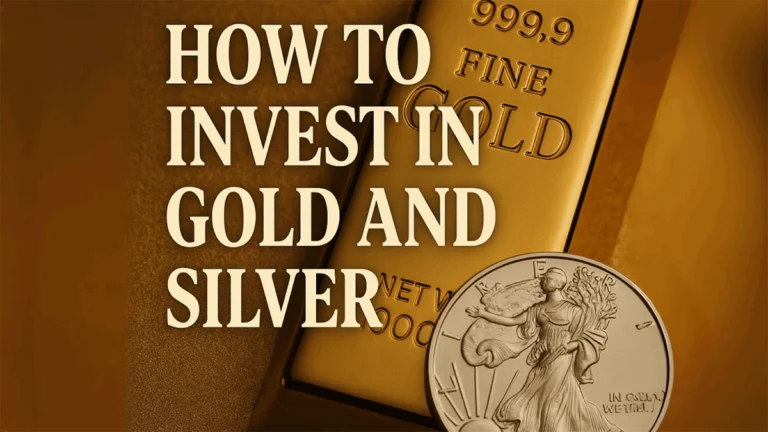Gold and silver have been trusted stores of value for thousands of years. They were used as currency, traded between nations, and valued as symbols of wealth. Even in modern economies, these metals maintain their significance, especially during periods of inflation or economic uncertainty.
Historically, when currencies weakened or stock markets faltered, gold and silver often held or increased in value. This resilience makes them attractive to investors seeking stability and long-term preservation of wealth. Both metals offer benefits that other asset classes cannot replicate, and their global acceptance ensures they can be traded or sold almost anywhere. According to the U.S. Department of the Treasury, gold and silver play a significant role in maintaining economic stability, making it a valuable hedge for investors.

Beyond their financial roles, gold and silver have cultural and industrial importance, contributing to their ongoing demand and relevance.
The Key Benefits of Adding Gold and Silver to Your Portfolio
Precious metals offer a unique set of benefits that appeal to both conservative and growth-minded investors:
- Hedge against inflation: Their value tends to rise when the purchasing power of currency declines.
- Portfolio diversification: They can reduce overall portfolio volatility by moving differently than stocks or bonds.
- Tangible value: Unlike digital assets or paper investments, gold and silver are physical, finite resources.
- Global liquidity: Widely recognized and accepted around the world.

For investors looking to balance risk, gold and silver can be effective tools for preserving wealth. They are not dependent on the performance of any one company or government, which can provide a sense of security when markets become unpredictable.
Gold vs. Silver: How They Compare as Investments
While gold and silver share similarities, they also have distinct characteristics:
- Price per ounce: Silver is much more affordable, making it accessible to smaller budgets.
- Volatility: Silver prices tend to swing more dramatically than gold, which can mean higher risk but also greater short-term gains.
- Industrial demand: Silver is used heavily in electronics, solar energy, and medical devices, making it sensitive to industrial cycles.
- Storage: Because silver is less dense, large investments take up more space than equivalent values of gold.
- Historical performance: Gold has been a more stable store of value, while silver has had periods of rapid growth.
Current Promotion: $15,000 in Free Silver on Qualified Purchases
Understanding these differences helps investors determine whether one metal, or a mix of both, better aligns with their goals.
Ways to Invest in Gold and Silver
Investors can choose from several methods, each with unique advantages.
Physical Bullion: Coins, Bars, and Rounds
Buying physical gold and silver means holding tangible assets. Popular products include American Gold Eagles, Canadian Silver Maple Leafs, and gold or silver bars of varying weights. Buyers should look for high purity levels (.999 fine silver, .9999 fine gold) and purchase from reputable dealers. Storage solutions include home safes, bank safety deposit boxes, or insured third-party vaults. Owning bullion provides direct control over your investment, but it also requires careful consideration of security.
Precious Metal ETFs and Mutual Funds
These funds track the price of gold or silver and trade like stocks. Physically-backed ETFs hold bullion in secure vaults, while some funds offer synthetic exposure through derivatives. ETFs provide liquidity and ease of trading without the need for personal storage. They also allow smaller, more frequent investments compared to buying physical bullion.
Want a more in depth look at buying gold? Check out our new article: How to Buy Gold for Beginners!

Mining Stocks and Streaming Companies
Investing in companies that mine or finance gold and silver operations offers indirect exposure. Returns can be amplified compared to metal prices but carry additional risks tied to business operations and market conditions. These investments may perform well when metals are in demand but can underperform during downturns.
Current Promotion: get your Free Gold IRA Guide Today!
Futures and Options Contracts
For experienced investors, gold and silver futures allow speculation on price movements without owning the metals. These contracts can offer high returns but also carry significant risk, making them unsuitable for most beginners.

Digital Precious Metals and Tokenized Assets
Some platforms offer digital ownership of gold and silver, backed by physical reserves. This allows fractional investing, easy transfers, and online storage. It can be a cost-effective way to access precious metals without managing physical storage.
Understanding Physical Precious Metals and Coin Investing
Physical precious metals, such as gold bullion bars, gold coins, and gold and silver coins, remain one of the most trusted ways to store wealth. Investors tend to choose these tangible assets because they are not tied to fiat currencies and can be easily sold to gold dealers worldwide. Gold price movements and silver coin values are influenced by supply and demand, stock prices of gold mining companies, and political developments that affect global markets.
Owning physical gold provides a sense of security, especially when stored securely to avoid storage fees and potential credit risk. Many retail investors purchase from reputable dealers recommended by the World Gold Council to ensure authenticity and fair market price.
Leveraging ETFs, Mining Stocks, and Futures for Gold and Silver Exposure
For investors who prefer liquidity, gold ETFs, silver ETFs, and other exchange traded funds allow you to gain exposure to gold investing and silver investing without taking physical delivery. These funds invest in physical metals or track futures contracts tied to the underlying asset. Gold mining stocks and gold mining companies can be extremely volatile, but they may pay dividends during profitable cycles.
Futures contracts in gold and silver can be significantly affected by interest rates, world events, and government regulations, making them suitable only for those with a high level of risk tolerance. When choosing ETF investments, compare the expense ratio, investment objectives, and whether they hold actual gold or other precious metals. A balanced investor’s portfolio may include physical assets, ETF investments, and positions in mining companies to provide diversification.
The Role of Central Banks, Industrial Uses, and Other Metals in Market Trends
Central banks play a significant role in the gold and silver markets by holding gold reserves and sometimes influencing prices through buying or selling activity. Industrial uses also impact prices—silver, platinum, and palladium are vital for electronics, catalytic converters, and other applications.
Precious metals may be significantly affected by world events, supply and demand shifts, and government regulations. Understanding these market dynamics helps investors determine the best way to allocate funds across gold, silver, and other metals, considering both investment and industrial value.
Managing Costs, Taxes, and Legal Considerations in Precious Metals Investing
When investing directly in gold and silver, costs extend beyond the market price. Buyers may face sales tax, storage fees, and premiums on bullion products. Legal tender coins may offer tax advantages in some jurisdictions.
Investors should also consider IRS rules for retirement account investments, ensuring compliance when holding gold or silver in a self-directed IRA. A financial advisor can help navigate these regulations, assess credit risk, and ensure the investment aligns with long-term financial goals and net worth objectives.
Strategies for Retail Investors and Diversifying Through Other Investments
Retail investors have several ways to gain exposure to precious metals, from purchasing shares in gold funds to adding physical metals to an investment account. Many investors choose to diversify by combining physical assets with ETF investments, gold-backed securities, and other investments such as government bonds or stocks and bonds.
The goal is to provide diversification and stability while still allowing for growth. Balancing precious metals with other assets can help protect against market volatility and changes in interest rates, supporting an investor’s portfolio in both stable and uncertain times.
How to Decide Between Gold and Silver (or Both)
The decision depends on budget, risk tolerance, and investment goals. Gold is often preferred for stability and wealth preservation. Silver offers greater growth potential and is more affordable. Many investors choose a combination to balance security and opportunity, creating a portfolio that benefits from the strengths of both metals.
How to Start Investing in Gold and Silver
Starting with precious metals requires careful planning:
- Define your investment objectives.
- Decide on your allocation between gold, silver, and other assets.
- Understand spot prices and dealer premiums.
- Work only with trusted dealers and verify authenticity.
A step-by-step plan helps ensure your investment fits within your broader financial strategy.
Spotlight on Hamilton Gold Group
Hamilton Gold Group is a trusted provider in the precious metals market. They offer gold and silver bullion, coins, and IRA rollover services. Their emphasis on transparency, education, and secure storage makes them a valuable resource for beginners who want to invest confidently. Partnering with a reputable dealer can help you avoid common mistakes and gain confidence in your investment decisions.

Current Promotion: Unconditional Buy Back Guarantee
Common Mistakes to Avoid When Investing in Gold and Silver
- Focusing only on one metal and missing diversification benefits.
- Paying excessive premiums due to lack of price comparison.
- Storing metals in unsecured or uninsured locations.
- Ignoring the liquidity differences between gold and silver.
Avoiding these pitfalls can protect both your assets and your potential returns.
Long-Term Strategies for Precious Metals Investing
Successful precious metals investors often:
- Rebalance their portfolios periodically.
- Monitor market trends and economic indicators.
- Maintain a balanced allocation with other asset classes.
- Use both gold and silver to capture their unique strengths.
Over time, disciplined investing and a willingness to adjust to changing market conditions can make gold and silver valuable long-term holdings.
Advanced Gold Futures and Market Dynamics
Gold futures are a key tool for experienced investors who want to lock in a market price or speculate on future results. They can also be used to hedge against economic conditions that may cause prices to fall. Futures contracts are often traded on major exchanges and may require a brokerage account with a firm such as Fidelity Investments.
Understanding the past performance of futures markets, as well as the main factors that influence them—such as supply disruptions, import controls, and wholesale prices—is critical. Many investors also monitor stock screeners and market news to identify opportunities on short notice. While the yellow metal is considered a single commodity, its value can be significantly affected by worldwide competition, changes in most currencies, and shifts in the earth’s crust that affect mining supply.
Legal, Practical, and Strategic Considerations for Maximizing Precious Metal Investments
When you buy precious metals—whether pure gold, gold bars, or gold jewelry—it is important to assess your investing objectives and financial situation. Consider working with third party providers or party providers who offer secure storage and insured transport. Many investors aim to accumulate as much gold as possible over several years, keeping a certain amount liquid for flexibility.
Most investors diversify their holdings between physical and paper assets, recognizing the different characteristics and industrial applications of each. Key takeaways for building a resilient metals portfolio include setting clear goals, understanding the total amount of your exposure, and preparing to take delivery if needed.
Public companies engaged in mining can offer growth potential, but like gold itself, they may be less predictable than other investments. Ensuring your strategy aligns with your long history of investing habits will help you navigate changing market landscapes.
Conclusion
Gold and silver each bring valuable qualities to an investment portfolio. Gold offers stability and long-term wealth preservation, while silver provides growth potential and affordability. By understanding their differences, exploring various investment methods, and working with trusted sources, you can build a balanced and resilient precious metals strategy. Whether you choose one or both metals, a thoughtful approach can help you achieve your long-term financial goals.
Investing in precious metals is not a get-rich-quick strategy, but it can serve as a reliable cornerstone in a diversified portfolio.
FAQs
It depends on your budget and goals. Gold is more stable, while silver is more affordable and has higher volatility.
Yes, silver often experiences larger price swings due to its industrial demand and smaller market size.
Yes, many self-directed IRAs allow for both gold and silver, provided they meet purity requirements.
Options include bank safety deposit boxes, home safes, and insured third-party vaults.
In the United States, both are generally taxed as collectibles, but specific rates may vary.
Top U.S. Brokers of 2025

★ ★ ★ ★ ★
✅ Now 23 million users
✅ Cash mgt account and credit card
Free stock up to $200 with new account, plus up to $1,500 more in free stock from referrals
Get Free Stock
★ ★ ★ ★ ★
✅ Access to U.S. and Hong Kong markets
✅ Educational tools
Deposit $100, get $20 in NVDA stock; Deposit $2,000, get $50 in NVDA stock; Deposit $10,000, get $300 in NVDA stock; Deposit $50,000, get $1,000 in NVDA stock
Get Free Shares
★ ★ ★ ★ ☆
✅ IBKR Lite & Pro tiers for all
✅ SmartRouting™ and deep analytics









